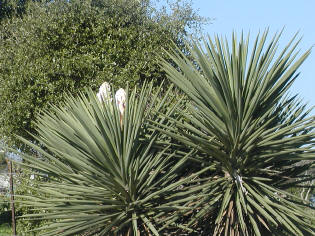Processing Yucca Fibers
by storm
Here is a quick and easy way to extract the long, white fibers from Whipples Yucca (Yucca whipplei) leaves.
Here are the tools I will use: smooth pounders and blunt scrapers. My favorite pounder (the black one at the top) is a 23 million year old piece of fossilized burnt wood that I found on the beach in WA. The pounder at the bottom is a slightly modified piece of Jeffrey Pine branch. The scrapers are slate and silver sheen obsidian (with the scraping edge ground on sandstone to blunt it).

Lightly pounding the yucca leaf will result in the fibers loosening from the epidermis and flesh of the leaf. As shown, that leaf resembles some ancient yucca paintbrushes that have been found at archaeological sites in southern CA.

Having pounded the front and the back of the entire leaf, I will now scrape with moderate pressure (make sure the scraping edge is blunt or you will destroy the fibers) and remove some of the skin and flesh of the leaf.

Results of the first scraping. Now I will wash the saponins (soap) and fleshy debris from the fibers and scrape them a second time. Removing as much of the chaff from the fibers as possible makes future cordage easier to make and somewhat stronger.

These yucca fibers have endured a third scraping with my fingernail and have been separated. They are ready to be made into fine cordage.

Here is ten feet of 4mm-thick, leg-rolled yucca cordage made from fibers that were scraped twice. Rope can be made from rough-processed fibersyou dont need to remove all of the chaff (especially for large-diameter rope). This ten feet took about 15 minutes to leg-roll.

by storm
Here is a quick and easy way to extract the long, white fibers from Whipples Yucca (Yucca whipplei) leaves.
Here are the tools I will use: smooth pounders and blunt scrapers. My favorite pounder (the black one at the top) is a 23 million year old piece of fossilized burnt wood that I found on the beach in WA. The pounder at the bottom is a slightly modified piece of Jeffrey Pine branch. The scrapers are slate and silver sheen obsidian (with the scraping edge ground on sandstone to blunt it).

Lightly pounding the yucca leaf will result in the fibers loosening from the epidermis and flesh of the leaf. As shown, that leaf resembles some ancient yucca paintbrushes that have been found at archaeological sites in southern CA.

Having pounded the front and the back of the entire leaf, I will now scrape with moderate pressure (make sure the scraping edge is blunt or you will destroy the fibers) and remove some of the skin and flesh of the leaf.

Results of the first scraping. Now I will wash the saponins (soap) and fleshy debris from the fibers and scrape them a second time. Removing as much of the chaff from the fibers as possible makes future cordage easier to make and somewhat stronger.

These yucca fibers have endured a third scraping with my fingernail and have been separated. They are ready to be made into fine cordage.

Here is ten feet of 4mm-thick, leg-rolled yucca cordage made from fibers that were scraped twice. Rope can be made from rough-processed fibersyou dont need to remove all of the chaff (especially for large-diameter rope). This ten feet took about 15 minutes to leg-roll.




